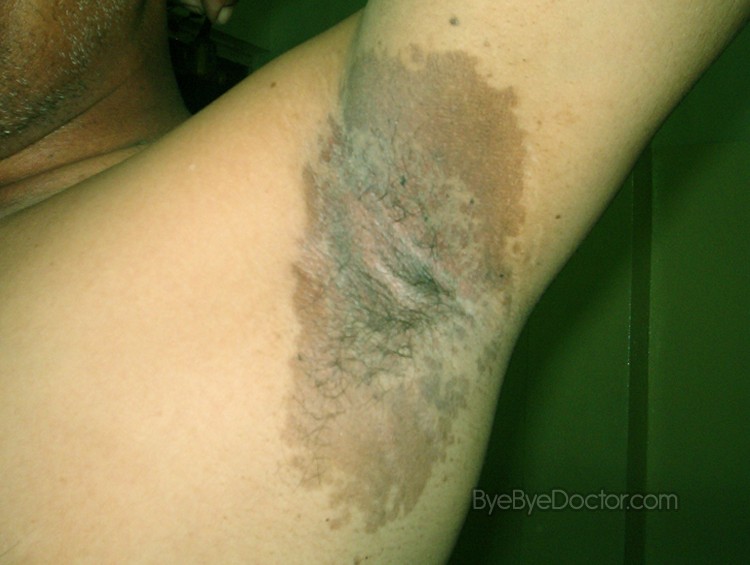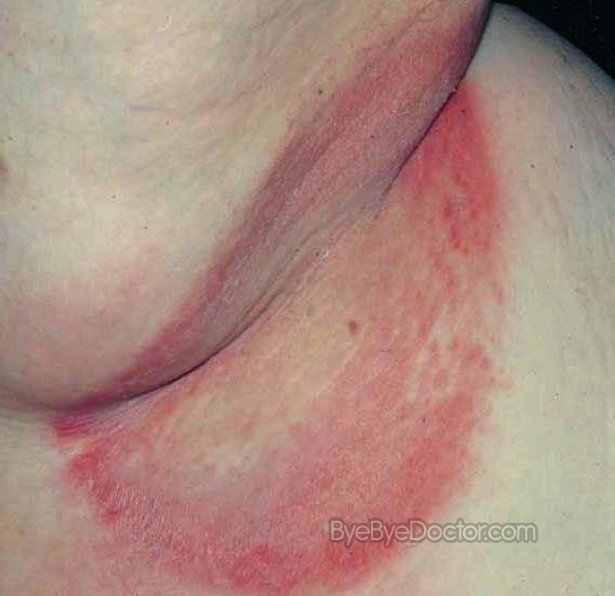Erythrasma
Last reviewed by Dr.Mary on October 3rd, 2018.
What is Erythrasma?
This is a bacterial skin infection that develops in the moist folds of the skin. The medical term for these folds found around the groin, armpits, and knees is “intertriginous skin.” The infection takes the form of raised, reddish-brown patches that often itch. If these patches are left untreated, they will turn scaly and brown. They also have a potential to spread. Erythrasma is unsightly in appearance but easy to treat and is not associated with any further conditions which are serious. The bacterium Corynebacterium minutissimum initiates the infection.
Erythrasma Symptoms
Erythrasma usually looks like a patch of red to pink, scaly skin. The border of the infection usually is well-defined, which means there is a sharp border between the patch and the surrounding skin which is normal. As time passes, the red or pink color will fade to tan or brown.
The infection is generally located in the body folds which are moist such as:
- In the groin and inner thighs
- Under the arms
- Between the toes, especially between the 4th and 5th toes
Common symptoms include:
- Skin appears pink or brown and very dry
- Reddish-brown, slightly scaly patch with sharp borders on the affected skin area
- Occurs in the groin, armpit as well as other skin folds
- Mild itching or burning sensation especially in the groin area
- Headaches, fatigue, swelling, and weight gain
- Pain in abdominal, chest, back, joint, urinary tract
Erythrasma is less commonly can be found developing in the buttock crevice or the folds underneath the breasts. There are some individuals, like those with diabetes, where the infection can become very widespread and can involve the arms, legs as well as the trunk.
The infection causes typically no symptoms, but some individuals do report mild burning or itching, especially in the groin area.
Erythrasma Causes
As stated before, the infection is instigated by the bacterium Corynebacterium minutissimum; so it is frequently confused with many other diseases of the skin. The rash of erythrasma is a very slowly enlarging area of brown or pink dry skin which has a scaly as well as a wrinkled surface.
This rash is generally seen in adult individuals. This disease is most frequently occurs in the tropic regions. It is most normally seen in the areas where skin touches skin, for example under the breast and in the armpits, webs of the toes as well as genital regions. It is seen mostly in men where the scrotum and the thigh touch.
This skin infection can affect individuals of any ethnicity or any age, but it is most common among people who live in humid, warm climates. It also is more common in dark-skinned individuals. Although both sexes are equally affected, males tend to have the infection in the groin area more frequently than females.
The below conditions can predispose individuals to erythrasma:
- Obesity
- Diabetes
- Poor hygiene
- Excessive sweating
- Immune deficiency
Erythrasma Treatment
Your primary care physician can normally diagnosis erythrasma by looking at the area. In some cases, he may need to use a Wood’s lamp which shines ultraviolet light on the skin which helps the doctor determine a diagnosis. Your doctor may even scrape a few areas with a small blade to gather specimens to send to the lab for a definite diagnosis.
The first treatment or self-care is to gently scrub the skin patches with anti-bacterial soap, and this may help the rash to go away. It may become necessary to have your primary care physician examine the rash and prescript gel or oral medication to help clear up the infection.
Once the diagnosis of erythrasma is made, the physician can try any of the following treatments:
- Topical antibiotic lotions such as erythromycin or clindamycin
- A solution of aluminum chloride inhibits moisture and sweating
- Whitfield’s ointment which is a mixture of benzoic acid and salicylic acid
- Oral antibiotics such as erythromycin or clarithromycin
The goals of pharmacotherapy for erythrasma are to eradicate the infection, prevent complications, as well as reduce morbidity.
Antibacterial and antifungal products are used to eradicate the bacterium and possible concomitant infection.
Photodynamic therapy which uses red light has been reported to clear erythrasma in 23% of patients in a research.
Erythrasma treatment as well as prevention tips:
- Maintain proper body weight as well as proper hygiene
- Avoid excessive heat or moisture
- Antibacterial soap used to avoid recurrence
- Drug erythromycin gel applied to the skin
- Antibacterial soap works to eliminate patches
- Substances to prevent sweating and moisture
- Erythrasma can be cured with an antiseptic such as Fusidic acid cream
- Extensive infection may be managed with oral antibiotics, for example, erythromycin or tetracycline
There are some measures which you can take to prevent this skin disorder. The most important one is to make sure that the skin is always dry after you get out of the shower and before putting on clothes. This prevents the bacteria from growing on any damp areas of the skin. If you have had erythrasma before, it is advised to wash with an antibacterial soap which may also help. Keeping yourself in healthy condition and trying to prevent excess weight and development of diabetes can also assist in the prevention of the development of this infection.



